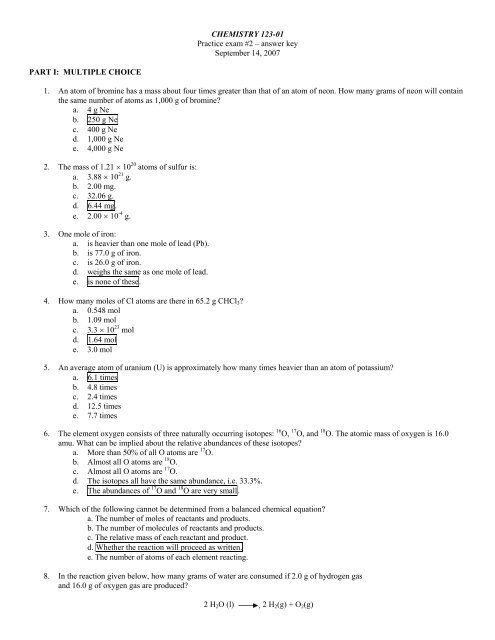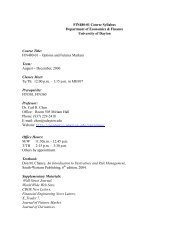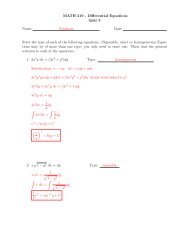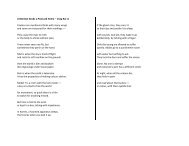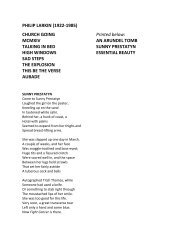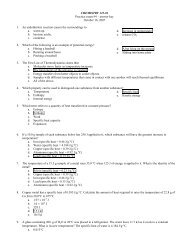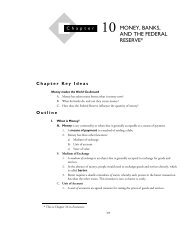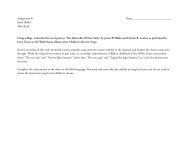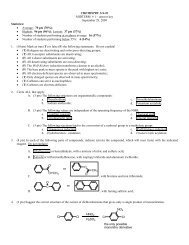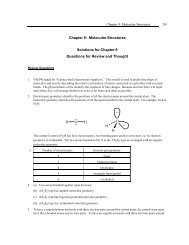CHEMISTRY 123-01 Practice exam #2 – answer key ... - Amazon S3
CHEMISTRY 123-01 Practice exam #2 – answer key ... - Amazon S3
CHEMISTRY 123-01 Practice exam #2 – answer key ... - Amazon S3
You also want an ePaper? Increase the reach of your titles
YUMPU automatically turns print PDFs into web optimized ePapers that Google loves.
PART I: MULTIPLE CHOICE<br />
<strong>CHEMISTRY</strong> <strong>123</strong>-<strong>01</strong><br />
<strong>Practice</strong> <strong>exam</strong> <strong>#2</strong> <strong>–</strong> <strong>answer</strong> <strong>key</strong><br />
September 14, 2007<br />
1. An atom of bromine has a mass about four times greater than that of an atom of neon. How many grams of neon will contain<br />
the same number of atoms as 1,000 g of bromine?<br />
a. 4 g Ne<br />
b. 250 g Ne<br />
c. 400 g Ne<br />
d. 1,000 g Ne<br />
e. 4,000 g Ne<br />
2. The mass of 1.21 × 10 20 atoms of sulfur is:<br />
a. 3.88 × 10 21 g.<br />
b. 2.00 mg.<br />
c. 32.06 g.<br />
d. 6.44 mg.<br />
e. 2.00 × 10 -4 g.<br />
3. One mole of iron:<br />
a. is heavier than one mole of lead (Pb).<br />
b. is 77.0 g of iron.<br />
c. is 26.0 g of iron.<br />
d. weighs the same as one mole of lead.<br />
e. is none of these.<br />
4. How many moles of Cl atoms are there in 65.2 g CHCl3?<br />
a. 0.548 mol<br />
b. 1.09 mol<br />
c. 3.3 × 10 23 mol<br />
d. 1.64 mol<br />
e. 3.0 mol<br />
5. An average atom of uranium (U) is approximately how many times heavier than an atom of potassium?<br />
a. 6.1 times<br />
b. 4.8 times<br />
c. 2.4 times<br />
d. 12.5 times<br />
e. 7.7 times<br />
6. The element oxygen consists of three naturally occurring isotopes: 16 O, 17 O, and 18 O. The atomic mass of oxygen is 16.0<br />
amu. What can be implied about the relative abundances of these isotopes?<br />
a. More than 50% of all O atoms are 17 O.<br />
b. Almost all O atoms are 18 O.<br />
c. Almost all O atoms are 17 O.<br />
d. The isotopes all have the same abundance, i.e. 33.3%.<br />
e. The abundances of 17 O and 18 O are very small.<br />
7. Which of the following cannot be determined from a balanced chemical equation?<br />
a. The number of moles of reactants and products.<br />
b. The number of molecules of reactants and products.<br />
c. The relative mass of each reactant and product.<br />
d. Whether the reaction will proceed as written.<br />
e. The number of atoms of each element reacting.<br />
8. In the reaction given below, how many grams of water are consumed if 2.0 g of hydrogen gas<br />
and 16.0 g of oxygen gas are produced?<br />
2 H2O (l) 2 H2(g) + O2(g)
a. 2.0 g<br />
b. 4.0 g<br />
c. 18.0 g<br />
9. In the reaction given below, for every unit of aluminum oxide consumed, how many<br />
atoms of aluminum are produced?<br />
a. 1<br />
b. 2<br />
c. 4<br />
2 Al2O3 4 Al + 3 O2<br />
d. 20.0 g<br />
e. 36.0 g<br />
10. The Roman numerals in the reaction given represent the coefficients in the balanced chemical equation. What are the values<br />
of the coefficients?<br />
I II III IV<br />
a. 2 10 6 4<br />
b. 1 10 6 4<br />
c. 1 10 3 4<br />
d. 1 5 3 4<br />
e. 3 5 3 4<br />
I C3H8 + II O2 III CO2 + IV H2O<br />
11. The Roman numerals in the reaction given represent the coefficients in the balanced<br />
chemical equation. What are the values of the coefficients?<br />
I II III IV<br />
a. 6 6 1 6<br />
b. 6 6 2 6<br />
c. 1 6 1 6<br />
d. 3 3 1 3<br />
e. 1 3 1 3<br />
I H2O + II CO2 III C6H12O6 + IV O2<br />
12. The Roman numerals in the reaction given represent the coefficients in the balanced chemical equation. What are the values<br />
of the coefficients?<br />
I II III IV V<br />
a. 4 4 4 4 3<br />
b. 4 2 4 4 3<br />
c. 4 4 4 2 3<br />
d. 2 2 2 2 3<br />
e. 4 2 4 2 3<br />
I KO2 + II H2O + III CO2 IV KHCO3 + V O2<br />
13. How many grams of CuCl are formed from the complete reaction of 0.750 mol of Cu with excess Cl2 (Pay attention to<br />
stoichiometry!!)?<br />
a. 32.2 g<br />
b. 43.6 g<br />
c. 74.5 g<br />
d. 1<strong>01</strong> g<br />
e. 148.5 g<br />
Cu + Cl2 CuCl<br />
d. 7<br />
e. 8
14. Which statement about the reaction of 10.0 g of carbon with 10.0 g of Cl2 is true?<br />
a. The equation, as written, is balanced.<br />
b. Carbon is the limiting reactant.<br />
c. Chlorine is the limiting reactant<br />
d. There will be 126 g of CCl4 produced.<br />
e. There will be 39.5 g of CCl4 produced.<br />
C + Cl2 CCl4<br />
15. What is the maximum possible quantity of product obtained from a chemical reaction called?<br />
a. limiting reactant<br />
b. theoretical yield<br />
c. percent yield<br />
d. molecular weight of the product<br />
e. stoichiometric coefficients<br />
PART II: CALCULATION PROBLEMS (Show your work in its entirety. Do not provide just a single number! Pay attention to<br />
significant figures!).<br />
16. The complete reaction of 16.12 g of titanium with 23.88 g of chlorine (Cl2) produces a compound with the formula TixCly.<br />
What is the empirical formula of the compound?<br />
Answer: We need to establish the ratio of moles of Ti and Cl, which will automatically give us the ratio of atoms (i.e. the<br />
empirical formula). Thus we start we conversion of grams into moles:<br />
# mol Ti = 16.12 g Ti x (1 mol/47.88 g Ti) = 0.3367 mol Ti<br />
# mol Cl = 23.88 g Cl2 x (1 mol/70.90 g Cl2) x (2 mol Cl/1 mol Cl2) = 0.6736 mol Cl (notice that we had to convert mol<br />
of Cl2 into mol Cl !!)<br />
The next step is to find the ratio of moles:<br />
0.6736 mol Cl/0.3367 mol Ti = 2/1<br />
The empirical formula is TiCl2<br />
17. How many grams of MgI2 are produced by the reaction of 75.0 g of Mg with 75.0 g of I2?<br />
Mg + I2 MgI2<br />
Answer: We first need to establish which is the limiting reactant. Let us start with assuming that we react the<br />
entire amount of Mg. It will require:<br />
75.0 g Mg x (1 mol/24.31 g Mg) x (1 mol I2/1 mol Mg) x (253.80 g I2/1 mol) = 783g I2<br />
In other words, it will require a lot more I2 than present, in order to consume the entire amount of Mg. At the point when all<br />
75.0 g of I2 is consumed, there will still be a considerable amount of Mg left. Therefore I2 is the limiting reactant and the<br />
subsequent calculation on the theoretical yield of Mg I2 must be based on the quantity of I2.<br />
75.0 g I2 x (1 mol/253.80 g I2) x (1 mol MgI2/1 mol I2) x (278.11 g MgI2/1 mol) = 82.2 g MgI2<br />
The reaction will lead to the generation of 82.2 g MgI2.
18. Allicin, a sulfur-containing compound found in garlic, is a potent antibacterial agent. A sample of 5.00 mg of allicin was<br />
burnt to produce 8.13 mg of CO2, 3.95 mg of SO2 and 2.76 mg of H2O. The molar mass of allicin is 160 g/mol. What is its<br />
molecular formula?<br />
Answer: First, let us convert the mg into gram quantities, using the conversion factor 1g/1000 mg.<br />
Sample: 0.00500 g CO2: 0.00813 g SO2: 0.00395 g H2O: 0.00276 g<br />
The product quantities can be used to find the amounts of C, S and H:<br />
0.00813 g CO2 x (1 mol/44.<strong>01</strong> g CO2) x (1 mol C/1 mol CO2) x (12.<strong>01</strong> g C/1 mol) = 0.00222 g C<br />
0.00395 g SO2 x (1 mol/64.06 g SO2) x (1 mol S/1 mol SO2) x (32.06 g S/1 mol) = 0.0<strong>01</strong>98 g S<br />
0.00276 g H2O x (1 mol/18.02 g H2O) x (2 mol H/1 mol H2O) x (1.<strong>01</strong> g H/1 mol) = 0.000309 g H<br />
If any oxygen was present in the compound, its quantity can be found from the mass of the sample:<br />
g O = 0.00500 g <strong>–</strong> (0.00222 g + 0.0<strong>01</strong>98 g + 0.000309 g) = 0.000491 g O<br />
Next we find the number of moles of each element:<br />
Mol C = 0.00222 g C x (1 mol C/12.<strong>01</strong> g) = 0.00<strong>01</strong>85 mol C<br />
Mol S = 0.0<strong>01</strong>98 g S x (1 mol S/32.06 g) = 0.0000617 mol S<br />
Mol H = 0.000309 g H x (1 mol H/1.<strong>01</strong> g) = 0.000306 mol H<br />
Mol O = 0.000491 g O x (1 mol O/16.00 g) = 0.0000306 mol O<br />
Construct ratios with common denominator:<br />
0.00<strong>01</strong>85 mol C/0.0000306 mol O = 6/1<br />
0.000306 mol H/0.0000306 mol O = 10/1<br />
0.0000617 mol S/0.0000306 mol O = 2/1<br />
This leads to an empirical formula: C6H10OS2<br />
The weight of this unit is: 6 x 12.<strong>01</strong> + 10 x 1.<strong>01</strong> + 16.00 + 2 x 32.06 = 162.28, which means that the empirical formula is<br />
also the molecular formula for this compound.<br />
The molecular formula is: C6H10OS2<br />
19. A hydrocarbon contains 82.7% carbon and the remainder hydrogen. Determine the empirical formula of the compound.<br />
Solution: Knowing the % of C and H, we know the gram quantities in 100 g of sample:<br />
82.7 g of C per 100 g of sample<br />
17.3 g of H per 100 g of sample<br />
Next we have to convert the gram quantities into moles. We have to use molar masses as conversion factors:<br />
# moles of C = 82.7 g x (1 mol/12.<strong>01</strong> g) = 6.89 mol<br />
# moles of H = 17.3 g x (1 mol/1.<strong>01</strong> g) = 17.1 mol<br />
Carbon and hydrogen are then in the mol ratio:<br />
mol C/mol H = 6.89/17.1 = 1/2.5 = 2/5<br />
The mol ratio is 2 mol C : 5 mol H, and the ratio of atoms is then 2 atoms C : 5 atoms H. Thus the empirical formula is: C2H5<br />
Answer: C2H5


